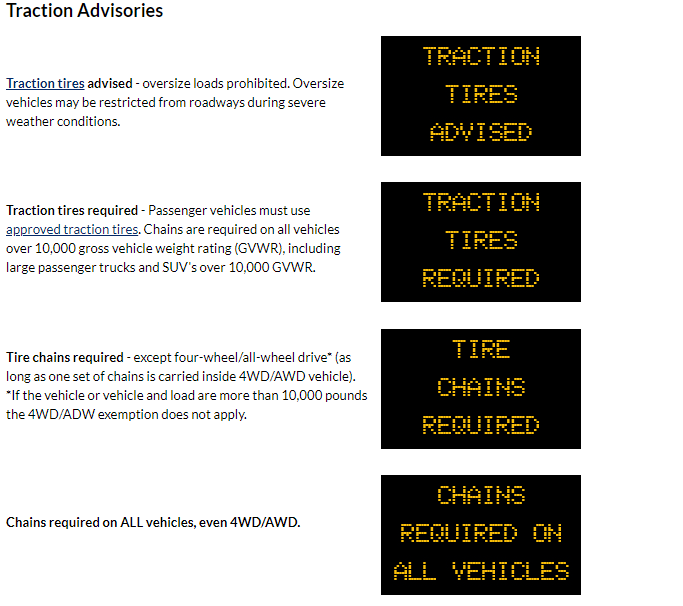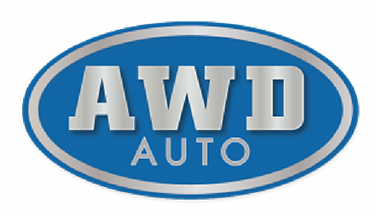Most modern Subaru vehicles cannot have tire chains installed. Which creates a lot of confusion when you see signs like these on the road. The hang up always seems to be that you bought your Subaru because it was All Wheel Drive and because it’s All Wheel Drive you never thought you would need to buy snow tires. In reality it is your best bet if you travel over the mountain passes in Washington State.
The following are signs or notices you’ll see as you venture up the mountain passes in the Winter months.

It seems every year as we ease or sometimes crash into the Winter driving season the question about putting chains on your Subaru always seems to come up. I am going to try and clarify once again for Subaru owners in Washington State. If you live in another state and are reading this you will need to check with the DOT (Department of Transportation) in the state where you reside to see if whats true in Washington is the same there.
I will start with the confusion WSDOT creates, so much so that I often wonder if they are confused themselves.. In Washington State if you own a Subaru with All Wheel Drive, you are exempt from the chains required rule under certain circumstances which I will discuss below.
Here is a the crucial snip it from the WSDOT website:
“Exemptions
Four-wheel/all-wheel drive vehicles are exempt from chain requirements when all wheels are in gear and are equipped with approved traction devices, provided that tire chains for at least one set of drive tires are carried in the vehicle. See WAC 204-24-050.” https://www.wsdot.com/winter/traction.htm
So what does that mean? If you have an All Wheel Drive Subaru and we already know that chains actually cannot be installed on most Subaru models, it means if you have approved traction devices your Subaru is exempt from the requirement provided you have a set of chains you cant possibly install in the cargo area. Now to try and better understand that requirement please see below.
WAC 204-24-050
Use of tire chains or other traction devices.
(1) Vehicles under 10,000 pounds gross vehicle weight. When traffic control signs are posted by the department of transportation it will be unlawful for any vehicle to enter the controlled area without having mounted on its drive tires the traction device specified by the sign, which must also meet the requirements of WAC 204-24-040. (a) Exception for all wheel drive vehicles. When “chains required” signs are posted, all-wheel drive vehicles will be exempt from the chain requirement when all wheels are in gear and are equipped with approved traction devices as specified in WAC 204-24-040 provided that tire chains for at least one set of drive tires are carried in the vehicle. (b) Alternative traction devices listed on the patrol’s web site as being approved for passenger vehicles as outlined in this chapter will be considered approved for use when “chains required” signs are posted.Then you must read
WAC 204-24-040
Traction devices.
The following equipment items are approved by the state patrol for use as traction devices wherever traction devices are required by the department of transportation: (1) Tire chains meeting the standards in WAC 204-24-020. (2) Studded tires meeting the standards in WAC 204-24-030. (3) Approved traction tires. An approved traction tire must have the following tread characteristics: (a) A minimum of 4/32 inch tread, measured in the center portion of the tire at three locations equally spaced around the circumference of the tire. (b) A relatively aggressive tread pattern designed primarily to provide additional starting, stopping, and driving traction on snow or ice. The tread must have ribs, lugs, blocks or buttons the edges of which are at an angle greater than thirty degrees to the tire circumferential centerline. (c) On at least one side of the tread design, the shoulder lugs protrude at least 1/2-inch in a direction generally perpendicular to the direction of travel. (d) Tires manufactured to meet these specifications must: (i) Be permanently labeled on at least one sidewall with the words “mud and snow” or any contraction using the letters “M” and “S” (e.g. MS, M/S, M-S, M & S, etc.); or (ii) Be permanently labeled on at least one side wall with the mountain/snowflake symbol. (4) Alternative traction devices. Any alternative traction device approved under this chapter must be used in accordance with the manufacturer’s recommendations concerning proper use of the product. The list of approved devices will be maintained on the patrol’s web site. Upon suspension or revocation of an approval for an alternative traction device, the device will be removed from the list of approved devices on the patrol’s web site.If you have a tire that meets the criteria such as a Snow tire with the snowflake on the sidewall or the designation M&S (Mud and Snow) and an approved traction device such as the Auto Sock in the cargo area this (according to WSDOT) meets the requirement as far as we can tell.
Here is a link to AutoSock on Amazon
Thanks for Reading
-Justin
Helping you with your Subaru

It’s the Rubber that meets the Road!
I’ve lived in Fairbanks Alaska 37 years.
There are basically 2 seasons here; fluid water & solid water. Each is roughly 5.5 months per year. It regularly gets chilly here (-10F ~ -30F chilly, lower = cold).
So we operate on snow-packed / icy roads extensively.
We LOVE Subarus! Have ’99 & ’02 Foresters & 2 Ford 4wd trucks.
We have 2 sets of wheels & tires for each: 1 set all-season radials & 1 set STUDDED snows.
Here’s the deal w/rubber:
All season tires go 40+K miles because the rubber compound is hard.
Beginning about +20F that compound gets much Harder, therefore traction on snowpack is significantly compromised.
Starting about -20F, there is a flat spot on the bottom of the tread if the vehicle was sitting awhile.
The tread gets so hard you must drive very slowly for a few hundred feet, until the “lump lump lump” goes away and the flat spot flexes normally again.
Snow Tires
Softer rubber compounds (wide range), aggressive tread
The softer compounds are much more flexible as temps decline; coupled w/aggressive tread Traction on snowpack/ice is Dramatically improved.
Apparently, Goodyear & Firestone use harder compounds; they work Way better on snowpack than all-season tires, but not as well as the rest.
Downsides:
Louder than all-season tires: YES, and studded versions definitely more so.
Reduced fuel economy: YES
Wear: Starting ~ +45F, tread wears faster than all-season tires, warmer = faster… with one exception.
The exception: General Altimax Arctic. Up to a point, this rubber compound gets Softer as temps Decline and Harder as temps Increase. Around +60 ~ 65F they start wearing faster than all-season tires.
The Stud Story:
Pretty sure ALL Departments of Transportation hate studded tires for good reason. Studs pick asphalt apart. Warmer is worse.
Testing shows .. On Dry Pavement .. studded snow tires don’t stop as fast as same tire w/out studs.
Testing shows .. On Pure Ice … (frozen lake, Not “black ice”) studded snow tires don’t stop as fast as same tire w/out studs.
IMO, the stopping distance differences are very modest, irrelevant in the Real World.
IMO studded snow tires consistently outperform those w/out studs on snowpack / icy & black ice road conditions.
Rubber/Road Bottom Line:
We used to have a Toyota Camry. On snowpacked / icy roads, the FWD Camry with 4 studded snow tires on Consistently OUTPERFORMED our Subaru Forester with 4 all-season radials on.
With studded snow tires all around both, the Forester blew the Camry away!
Thanks for sharing
-Justin